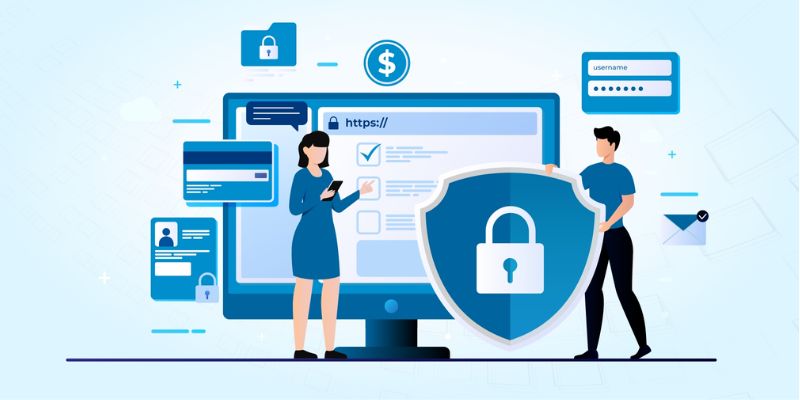Are your dollars as secure as you think? When it comes to the security of fintech payment platforms, knowing the ins and outs is crucial. Let’s pull back the curtain on the truth behind your fintech security. Is it a safe house or a house of cards? Here, you’ll learn if your chosen platform is the Fort Knox of finance or if your hard-earned cash needs a better guardian. With sneaky cyber thieves lurking, get the lowdown on your fintech’s armor and weapons. It’s time for a security health check—let’s dive in!
Assessing the Armor: Understanding Your Platform’s Payment Security Measures
Implementing Multi-Factor Authentication and Biometric Verification
Let’s talk locks and keys. Imagine your fintech platform as a secure home where your money sleeps safe. Just as you wouldn’t use a simple lock for your front door, secure fintech platforms also need strong locks. One of the best locks in the fintech world is multi-factor authentication for payments. It’s like asking for a secret handshake after the lock turns. This means you need more than a password to get in. You might be asked for a code from your phone or even your fingerprint.
Biometric verification in fintech adds an extra layer. It checks who you are with unique things like your voice or face – think of it as high-tech doorbell cameras. Only the real you gets in, keeping your money out of the wrong hands. This keeps fraudsters guessing and your hard-earned cash secure.
Compliance with Standards: Navigating PCI DSS and PSD2 for Secure Payments
Now, onto the rules of the road. Ever see those street signs that guide you safely? Financial data works the same way, with signs like PCI DSS compliance in fintech and PSD2. These aren’t just fancy acronyms. They’re like strict parents for your payment platform, setting rules on how to keep your money safe.
PCI DSS stands for Payment Card Industry Data Security Standard. Think of it as a checklist of what to do to guard card info. It’s a must-do for every platform that handles credit or debit cards. It tells you how to protect card numbers, keep systems safe, and even how to react if trouble finds you.
PSD2 is another set of rules, mostly for payment services in Europe. It mixes protection with freedom, letting you safely shop around for better money deals. With PSD2, your financial secrets stay secret. Only you pick who gets a peek into your account, like budgeting apps or payment services.
Follow these rules, and your fintech platform becomes like Fort Knox. A fortress, not just a lockbox. It turns your platform into a place where money moves like ninja – silently and unseen, but always guarded.
In the vast world of money moving online, guarding against payment fraud and data theft is like a never-ending game of cat and mouse. With every swipe, click, or tap, it’s essential to know your platform’s got your back with solid security measures. Now you can sleep a little sounder, knowing your digital dollars have the digital equivalent of guard dogs, laser beams, and steel doors protecting them every step of the way.

The Shield of Encryption: Fortifying Transactions and Data
The Role of End-to-End Encryption and Tokenization in Fintech
What is end-to-end encryption? It’s a way to keep your chats secret. Only you and the person you talk to can read them. In fintech, it’s just as vital. Here, it hides your payment details when you buy things online. No one else can see it, not even the payment platform.
Let’s dig deeper. When you pay, encryption scrambles your card info into a code. Only the right person at the other end can make sense of it. It’s like sending a secret message that only your friend knows how to read. Tokenization takes your card number and swaps it for a one-time code. It’s like using a fake treasure map that only works once. If bad guys get it, it’s useless.
Fintech firms use these tactics for a strong reason. They keep your money talks locked up tight. With things like SSL and TLS, it’s like having a super guard for your data. They watch over your transactions, no breaks, no slip-ups. This tech talk matters because it shields us from thefts in the digital world.
Protecting Digital Identity with Advanced Encryption Tactics
Now, imagine your digital self. It’s who you are when you’re online. Just like you lock your front door, you need to lock up this digital self too. Encryption is the key to that lock. It makes sure your private stuff, like your shopping list or bank PIN, stays just yours.
Fintech takes this seriously. They use tough methods to lock down your digital self. They mix up your info in ways that are super tricky to untangle. This keeps sneaky hackers away from your digital door. Plus, these fintech folks keep improving their locks. They stay ahead, so even the craftiest hackers hit a big wall.
In this cyber realm, we’ve got big rules to play by. They make sure everyone who handles your cash info does it in a super-safe way. And these payment platforms must check and double-check their shields. They can’t let any cracks show. So they use audits to find flaws before the hackers do.
Encryption doesn’t just keep secrets. It’s the hard armor around your money moves. And the best part? It works quietly behind the scenes. You shop or pay bills online without a worry. Your data is like a safe buried deep in a fortress. And that’s what makes end-to-end encryption and tokenization the heroes in our fintech story.
Sure, most of us don’t see these security puzzle pieces. But they’re always there, working hard. They turn our online money moments into safe, smooth talks. They’re the silent guardians of our digital dollars. And for us running in this fast fintech race, they’re what keep us one step ahead of the baddies out there.
So next time you pay online, remember the invisible shield of encryption. It’s your secret armor, keeping your digital dollars safe round the clock.

The Vanguard of Vigilance: Real-Time Fraud Detection and Prevention
Leveraging AI and Machine Learning for Proactive Fraud Detection
Imagine a guard that never sleeps, always on the lookout for bad actors trying to steal your money. That’s AI for you in fintech payment security measures. Banks have used it for years, and now it’s a big deal in fintech too.
AI and machine learning see patterns in how we use money. If something seems off, they can tell almost right away. It’s like having a super-smart friend who always knows if someone’s trying to trick you.
What’s the secret to their success? These tools learn over time. The more they work, the better they get at stopping fraud in digital payments. They watch for scary things like strange spending or logins from far-away places.
Now, you might worry: Will AI make mistakes? Can it think someone’s a thief when they’re not? Sure, it can happen. But fintechs work hard to teach AI the right from wrong. They keep making it smarter day by day.
Risk Management Strategies in Combatting Phishing and Payment Fraud
Risk management is like the rules of a game. The rules tell you what to do to win—or in our case, to keep our money safe. First, there’s training. Everyone who uses the payment platform needs to know how to spot a thief. Then, there’s planning. If a thief gets in, fintechs have a plan to kick them out fast.
Now, let’s talk phishing. It’s when someone tries to trick you into giving them your info. They might pretend to be your bank or a store. To fight back, fintechs use something called multi-factor authentication. It’s like a secret handshake. Only you and the fintech know it. This way, even if a thief has your password, they can’t get your money.
They keep your money safe with encryption tactics for online transactions too. Think of it as a secret code. Only the person sending the money and the one getting it can understand it.
And there are other tools, like digital identity verification and biometric verification in fintech. These are fancy ways of making sure it’s really you using your money, not an imposter.
When you combine all these things, you get super strong fintech payment security measures. And that keeps your money as safe as it can be. So, the next time you tap your phone to pay for a snack, remember there’s a whole bunch of smart tech working to protect your cash. And that’s pretty cool.

Building the Bulwark: Trends and Innovations in Fintech Cybersecurity
Blockchain Application in Enhancing Payment Platform Integrity
Imagine a wall so tough that nothing bad can pass through it. This is what blockchain is to fintech. It’s like a digital ledger that no one can cheat. When payments happen, the details get locked in blocks. These blocks then link together in a chain. Nobody can change these details once they’re in.
Blockchains create trust in fintech payments. They track every move. This makes stealing or changing payment info super hard. It’s a smart way to keep everyone’s money safe. It’s not just for Bitcoin but for all kinds of digital payments.
Cloud Security Measures and Secure Digital Wallets for the Fintech Ecosystem
Think of the cloud like a bank vault in the sky. But instead of gold, it holds data. Banks use thick walls and locks to keep gold safe. Cloud security does this for data with codes and checks. It protects against hackers who want to steal your info.
One of these checks is called multi-factor authentication. It asks for more than just a password. Maybe it’s a fingerprint or a code sent to your phone. This makes sure it’s really you trying to get in.
Digital wallets are like having a bank in your pocket. But they must be locked down tight. Just like you wouldn’t leave your wallet lying around, fintech needs to keep digital wallets secure. They use encryption. It scrambles data so only the right person can read it.
The cloud helps here, too. It can quickly find and stop fraud as it happens. Banks and fintech firms work hard to make sure these wallets are as safe as can be. They follow rules, like PCI DSS. This means they do things in ways that have been OK’d for safety.
Making payments without touching anything is also getting big. This contactless pay is quick and easy. But it must be secure, just like when you pay with a card or phone. Firms work to make sure bad guys can’t grab your payment info out of the air.
In fintech, things change fast. Hackers get smarter, but so does the tech that stops them. Think of it as a game of cat and mouse. Firms must stay ahead to keep your money safe. They use the latest tech and smart tactics. And they keep on learning and getting better at fighting off risks.
In the end, they’re building a fortress. One that keeps your money and info locked down tight. As an expert in this field, I always watch for new tools and methods. We all want one thing: to make fintech a Fort Knox for finance.
We dove into how to keep your online payments safe. First, we talked about using things like two-step checks and body scans to stop bad guys. Then, we explained rules like PCI DSS and PSD2 that help protect your card info.
Next up, we looked at how coding all data from start to end—and turning sensitive details into codes—keeps your identity safe. We learned that smart tech spots fraud fast and keeps your money safe. And, knowing the tricks crooks use can help you stay one step ahead.
Lastly, we explored new shields in finance tech, like blockchain and cloud safety. These tools are building a tough wall to guard your cash online.
To end, keeping your money safe in the tech world takes staying sharp and using the best shields out there. And remember, the smartest move is to stay updated on ways to fight off threats to your digital dough. Stay safe out there!
Q&A :
How secure are fintech payment platforms?
Fintech payment platforms employ advanced security measures such as encryption, two-factor authentication, and continuous fraud monitoring to protect users’ financial data and transactions. They adhere to strict regulatory standards like PCI DSS (Payment Card Industry Data Security Standard) to ensure security compliance.
What encryption methods do fintech platforms use to safeguard transactions?
Most fintech platforms utilize end-to-end encryption (E2EE) to protect data transmitted during transactions. This means that information is encrypted from the moment it leaves the user’s device until it reaches its destination, rendering it inaccessible to unwanted third parties.
How does two-factor authentication enhance fintech security?
Two-factor authentication (2FA) adds an extra layer of security by requiring two types of credentials before granting access to an account or confirming a transaction. Typically, this involves something you know (like a password) and something you have (such as a smartphone for receiving a verification code).
Are there regulatory bodies that oversee the safety of fintech payment platforms?
Yes, fintech payment platforms are subject to various regulatory bodies depending on their geographical location and operational nature. Examples of these bodies include the Financial Conduct Authority (FCA) in the UK and the Consumer Financial Protection Bureau (CFPB) in the US.
What should users do to protect themselves when using fintech payment services?
Users should follow best practices such as safeguarding their passwords, avoiding public Wi-Fi for financial transactions, regularly monitoring their accounts for unauthorized activities, and keeping their devices’ software up-to-date to maintain personal security on fintech platforms.

